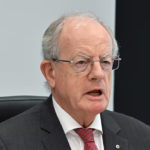Arvanitakis on American politics

It is easy for those who do not like President Trump to find stories that corroborate with their views, suggesting that he has no chance of re-election in 2020 – a classic case of ‘confirmation bias’.
Stories of the President’s unpopularity are plentiful and were boosted this week when conservative radio show host and former lawmaker, Joe Walsh, joined Former Massachusetts Governor Bill Weld in announcing he would challenge for the Republican Party’s 2020 White House nomination.
Challenging an incumbent president is nothing new: both Gerald Ford and Jimmy Carter faced very significant challenges when they sought a further term.
So obsessed are parts of the media with feeding ‘bad news’ about Trump, that Fox News have even given it a label: Trump Derangement Syndrome.
Living, working and travelling around Wyoming, a deep red conservative state, I have tried to look beyond media circles to unpack what is happening with Donald Trump’s presidential chances, and to understand what is happening with the Democrats as they seek their next presidential candidate.
What is it about Trump?
Recently, the New York Times reported that despite all the news and scandal many of us love to rea about Donald Trump, both his personal favourability and approval ratings have increased and are higher than 2016. The article notes that many of the most respected public opinion polls have “had inched up to essentially match the highest level of his term.”
Understanding Trump supporters is not straightforward. Yes, there are a significant number (his base) that agree with his policies, from ‘building the wall’ and anti-immigration rhetoric, to a belief that the United States has been taken advantage of by adversaries and allies alike.
But his appeal is not limited to those that are anti-immigration and anti-cosmopolitan.
I have also found a significant number who are indifferent towards Trump or his history. What makes Trump popular amongst a certain section of his supporters is that he is seen as an outsider, who is telling the political establishment (and by extension ‘the elites’) to ‘Go to hell’ (Note: Americans are so much more polite than Australians).
Over the last three decades, we have witnessed a hollowing out of the middle class in both the USA and Australia; in fact, this is common across most OECD nations.
There should be little wonder that when someone comes along and trash talks the institutions and the political parties (be they centre-left or centre-right) that laid the path that got us here, that person is popular.
Then there are those who have moved from being anti-Trump to pro-Trump – including high profile ‘Never Trumpers’ such as Ben Shapiro. As Lawrence B. Glickman wrote in the Washington Post, this is as much about seeing Trump as doing a good job, as demonstrating “how the ideological convictions and partisan loyalty of most politicians lead them to embrace the leader of their party even if they find some of that person’s views and conduct distasteful.”
And what about the Democrats?
The second reason why you should not assume that the the Trump Presidency will end is the Democrats struggle to find a leader to unite them.
The Democratic debates highlighted gaps between the reformist and centrist wings of the Party. After five hours of debating, there were four leading candidates emerged.
The first is former Vice President, Joe Biden. While seen as having the best hope of capturing the broader electorate, Biden seems unsure of why he is running. As Jonathan Allen and Amie Parnes highlighted in Shattered: Inside Hillary Clinton’s Doomed Campaign, Clinton could never articulate to the broader electorate why she should be elected – one of the reasons she failed to appeal to a broader section of the electorate.
Likewise, when recently asked why he wanted to be President, Joe Biden’s response was “I think it’s really, really, really important that Donald Trump not be re-elected”. This is hardly something that will inspire those beyond the Democratic base.
Bernie Sanders remains popular with an incredibly strong and loyal following. Like the lead-up to the 2016 primaries, he is shaping much of the Democrats discourse about reform, but his ideas are seen as far too radical by many in the mainstream.
Sanders seems to see himself as the heir to Franklin Roosevelt’s social democratic reforms post World War II (the ‘New Deal’). He has presented ideas that many Australians are comfortable with, like ‘secure retirement’. However, many Americans see his policies as splashing away their tax dollars. Branding his reforms as ‘democratic socialism’ has done him no favours.
The third candidate is Senator Elizabeth Warren. Warren is becoming increasingly popular amongst Democrats and she pulls big crowds at rallies (and starting to draw big money). Despite this, many Democrats don’t think that she has what it takes to beat Trump. Some polls now place Warren on equal footing as Biden and Sanders. Like Sanders she has taken some more ‘radical positions’ on universal health care and taxation.
Her grasp of policy and ‘rags to riches’ story make her an ideal candidate to confront some of Trump’s blustering, but she has already been the target of his ridicule. Trump called her ‘Pocahontas’ in response to her First Nations heritage. Such mockery is an affront to many of us, but it plays into Trump’s showmanship and has done nothing to damage him amongst his supporters.
The fourth potential candidate is Senator Kamala Harris – who represents generational change and claims to transcend gender and racial politics. Despite garnering a strong base, polling at just over 10 percent, she is seen as inspiring but has a slim chance of winning the nomination.
None of this means that the re-election of Trump is a certainty. If nothing else, we have learnt that little is certain in politics. However, the election is there for Trump to win not only find a leader to unite them but can frame any reform in a way that will appeal to the broader American public. This may not be what you want to read, but it is what is being played out in America away from the big cities and many major media outlets.
Professor James Arvanitakis is the Executive Director of the Australian American Fulbright Commission – one of the world’s most prestigious international education and cultural exchange programs.













